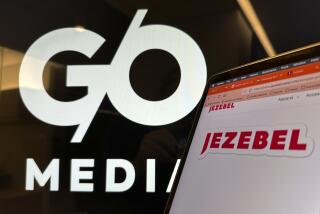Egg and Entertainment Weekly Hatch Their Own Ideas of Fun : Magazines: Malcolm Forbes’ latest venture aims for the chic club-going set. Time Inc. targets Middle America.
- Share via
Rotten? Soft-boiled? Scrambled?
When Malcolm Forbes decided to call his new, heavily hyped bicoastal night life magazine “Egg,” he was inviting bad puns.
Some of them seem appropriate. But before we give this primping Humpty Dumpty a shove, let’s look on the sunny side of Egg--which, along with Time Inc.’s new Entertainment Weekly, is giving itself a nightclub launch party in Los Angeles this week.
Ever since Forbes lost his bid to buy Interview and announced he would create Egg instead, folks in publishing circles have been wondering what it would be about and what the name means.
Most assumed the title was inspired by Forbes’ fixation with Faberge eggs. Most assumed it would concern itself with equally important issues.
It seems they were wrong. In part. The name, according to editor Hal Rubenstein, doesn’t mean a thing: “My sister pulled the word out of nowhere one day, and we thought it was funny.”
As for what the magazine is about, in his editor’s note, Rubenstein writes: “Egg is about fun. That’s it. Fun.”
In his own opening statement, which reads a bit like a groovy beatnik rap, Forbes informs us that “there’s a whole, pulsating Life After Eleven we never knew was out there. In New York and Los Angeles and some other making/shaking cities around the country. . . . “
Egg, Forbes proclaims, will guide a vanguard of trendies through the chaos of clubdom, protecting elite chicsters from the heartbreaking humiliation of discovering a club or label that is already declasse.
Among other things, the magazine is notable for its willingness to look at the gay aspects of the club scene. Rubenstein said that Egg has not intentionally slanted any articles to a gay readership. But, he adds, “If you’re going to talk about night life in New York or Los Angeles and not talk about gays, you’re lying.”
The problem for the magazine, which launched itself with 145,000 copies and a healthy base circulation of 40,000--not to mention 101 ad pages--will be how to remain eclectic and still maintain a steady readership of any sexual preference.
Rubenstein isn’t worried. He was writing popular columns and features on food and entertainment for such publications as Details, 7 Days, Elle and Vanity Fair when Forbes invited him to join the Egg masthead. He thinks Egg will draw readers of from all those publications and others with its eclectic mix of features.
The first issue of the monthly ($2.50) offers a seven-page guide to New York’s night scene that is hip--as well as graphically gripping, witty and utilitarian.
Egg’s charts track vital club statistics ranging from the degree of pain inflicted by various sound systems to “the number of well-known people seen,” and “the percentage of men and women with ponytails.”
Club-goer’s will want to know, for instance, that the median age at Stringfellows is 35, while only 20 at Love Transporter; that the maximum occupancy at Private Eyes is under 500 and the Palladium holds more than 2,000; that the ratio of black clothes to clothes of other colors is better than 90%-10% at several clubs and more than 60%-40% at all but a few.
(No irony is apparent when another article pities the poor East Germans for their monochromatic clothing.)
Another interesting feature takes designer Geoffrey Beene out on a shopping spree along New York’s proletariat 14th Street. The piece demonstrates that for under $100, someone who knows what they’re doing can put together a 100% black outfit that looks a lot like the expensive 100% black outfits featured in 87% of Egg’s fashion ads.
Other articles and columns focus on food, gossip, and celebrities from various fields, most of whom won’t be found in Fame magazine. One peculiar pictorial features New York firefighters in macho poses, one exposing his chest.
Some readers may be annoyed by the magazine’s often trivializing tone that occasionally wobbles towards a sort of cloying camp.
“The Guys in the Freudian Slips,” for instance, is a profile of three female impersonators who’ve made a splash on Broadway. One of them, Charles Busch, asserts in the piece that “behind every woman is a man who wants to get his hands on her lipstick.”
What’s more, the cover story on Mary Hart’s legs is enough to send even a People magazine devotee in search of more substantial reading matter.
In any case, the magazine as a whole is too caught up in the spirit of Hart’s own immortal words: “People today have an incredible interest in celebrities, and my legs are part of that.”
For all the energy and talent thrown into Egg, you’d think they’d dish up a better omelet. As it is, even the most mindless of trendies will find too much in the magazine that hardens their cerebral arteries.
Using the ingenious rating scale devised by Entertainment Weekly, Egg gets a C.
Like Egg, Entertainment Weekly is about fun. But it’s about the kind of fun sensible, Middle Americans have at a reasonable hour, preferably in the comfort of their own homes.
Even the folks who get a few hours of sleep a night, though, know that time is money. And for $1.98 an issue, Entertainment Weekly will tell readers, in very little time, how to get the most for their money.
To do this, the publication spews forth dozens upon dozens of snippets, blurbs, factoids, and summaries of all the television programs, movies, videos, music, books and magazines an American might choose from in a week.
Nothing elitist about this publication. It has a target circulation of 600,000 for its first year. But it really covets all 250 million of us. Except, perhaps, the clubbies who subscribe to Egg. And a few overly serious New Yorker readers.
The pervading philosophy of the magazine can be found in managing editor Jeff Jarvis’ opening remarks. These are listed as 10 commandments, but the crux is revealed in No. 9: “Short is fine.”
“We won’t have long, ponderous, pompous articles about show biz . . . , “ Jarvis promises the Philistines.
So a seven-paragraph review of a television show informs us: “Merely by reminding us of that period of history, ‘A Nation of Law?’ stirs up exhilarating ideas, arguments and emotions.”
Who has time to wonder what those ideas, arguments and emotions might be?
This is sushi bar journalism--USA Today on speed. But for what it is, it works well. The reviews--even the whopping, approximately 1,000-word piece on the biography of poet John Berryman--will not leave readers ruminating about the meaning of life.
But they are smart, well-written, and often witty.
Most of the news and notes running down the sides of the pages are distracting and irrelevant to even a die-hard television addict.
But here and there this hailstorm of factoids turns up something fun or even significant (take, for instance, the “Grammy Hall of Shame,” box, which makes graphically clear how absurd those music awards tend to be).
On the Entertainment Weekly curve of grades from A+ to F, Entertainment Weekly gets a C+.
World Press Reviews Invasion of Panama
What did the world think of the U.S. invasion of Panama? The February World Press Review presents the views of newspapers around the world. Reactions are pretty much what readers would expect. In Mexico’s Excelsior, for instance, author Carlos Fuentes portrays the United States as a cowardly bully whose concern for Panama’s democracy “is not convincing on a continent where Trujillo, Somoza, Pinochet, and the Argentine junta came to power and survived with U.S. assistance and goodwill.”
On the other hand, as The Australian saw things, “Ridding the world of the scourge of Noriega . . . is as worthwhile a cause as there can be.”
In the same issue, WPR presents it’s annual catalogue of the most important stories of the year, as seen by various news agencies. As usual, there is considerable discrepancy between how U.S. news people see the world as opposed to their colleagues abroad.
There was no mention on the U.S. lists, for example, of the fall of Indian Prime Minister Rajiv Gandhi, Japan’s corruption scandal, the Death of Khomeini, the rise of environmental Green parties, the departure of P. W. Botha in South Africa, or other events foreign agencies saw as earthshaking.
At the same time, no foreign agency listed the San Francisco quake.
Universally, however, agencies saw the decline of communism in Eastern Europe and the setback of the pro-democracy movement in China as extremely significant.
There were, however, certain differences in how those events were seen. The pro-government China Daily, for example, listed the stories like this: 1. Chinese government puts down counterrevolutionary rebellion in Beijing.
2. Drastic changes in East European political situation.

